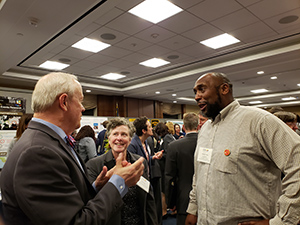
Zero Forcing and Electric Power Systems Presented on Capitol Hill
The AMS sponsored an exhibit on Zero Forcing and electric power systems at the 25th annual Coalition for National Science Funding (CNSF) Exhibition & Reception on Capitol Hill held April 30, 2019. Professor Michael Young, Iowa State University, presented "Power Domination: How Zero Forcing is Used to Monitor an Electric Power Grid."
Dr. Young presented his work to Congressional representatives and other interested attendees by explaining:
"In our work to enhance efficiencies in our nation’s power grid, we employ tools from theoretical graph theory. To see how this works, we consider a graph with each vertex colored either blue or white. If a white vertex is adjacent to a blue vertex, and it is the only white vertex adjacent to that blue vertex, then the white vertex switches to blue. This process is referred to as the zero forcing. If the white vertices of a graph all turn blue under this process, then the beginning set of blue vertices is a zero forcing set of the graph.
Zero forcing can be used to determine where to place Phasor Measurement Units (PMUs) in an electric grid. These units measure voltage and current locally in a power grid and can be placed strategically to obtain measurements for the entire grid. More specifically, given the data that a PMU measures locally in a grid, Kirchhoff's law and Ohm's law allow for the entire grid to be measured if the PMUs form a power dominating set (meaning that these locations and their neighbors in the graph form a zero forcing set). According to the Department of Energy, the average overall cost per PMU in 2014 (cost for procurement, installation, and commissioning) ranged from \$40,000 to \$180,000. Thus, minimizing the number of PMUs installed is desirable."

The Coalition for National Science Funding (CNSF) is an alliance of over 130 organizations united by a concern for the future vitality of the national science, mathematics, and engineering enterprise. CNSF supports the goal of increased national support for the National Science Foundation's (NSF) research and education programs. The CNSF Exhibition is a well-attended annual event that features thirty-five exhibits where researchers present their work and explain the critical importance of sustained federal investments in basic scientific research.
Learn more about CNSF and its Capitol Hill exhibitions.
 |
 |
Michael Young is an Associate Professor of mathematics at Iowa State University (ISU). His primary research area is Discrete Mathematics, particularly graph theory and combinatorics. Recently, he has had a focus on equity in the mathematics classroom and is responsible for establishing the Mathematicians of Color Alliance (MOCA). MOCA is a group of minority graduate and undergraduate mathematics students whose goal is recruitment, retention. and mentoring of underrepresented students by creating a presence in the department, on campus, and around the nation. In addition, Dr. Young is co-director of ISU’s Postbaccalaureate Certificate in Mathematics.
Previous AMS exhibits at CNSF Exhibitions include:
- Beyond Coursework: Extending a Successful Model for Building Diversity in STEM to University Campuses presented by Talea Mayo, University of Central Florida
- Berry Smart: Mathematics for Food and Water Security presented by Lea Jenkins, Clemson University
- On the Movement of Cells, Birds, Fish and Other Agents: Mathematical Modeling in Biology and Ecology presented by Konstantina Trivisa, University of Maryland
- Mathematical Algorithms for Space Weather, Tsunamis, and Plasma Physics presented by Katharine Gurski, Howard University
- Topological Sensor Networks presented by Robert Ghrist, University of Pennsylvania
- The Boltzman Equation: Where Mathematics and Science Collide presented by Philip T. Gressman, University of Pennsylvania
- ICERM: Connecting Mathematics and Computing through Experimentation presented by Jill Pipher and Lauren Barrows, ICERM
- Efficient Energy Conversion: Mathematics of Nanoscale Networks presented by Keith Promislow, Michigan State University
- Industrial Modeling and Simulation: The Wave of the Future presented by Susan Minkoff, University of Maryland-Baltimore County
- Modeling Outbreaks in Agricultural Systems, Human Communities and Computer Networks presented by David Hiebeler, University of Maine
- Mathematics and Cardiology: Partners for the Future presented by Suncica Canic, University of Houston
- Computational Models for Cardiovascular Disease Assessment and Surgery Design presented by DalinTang, Worcester Polytechnic Institute (WPI)
- Disease Prediction and Treatment Design presented by Eva K. Lee, Georgia Institute of Technology
- Mathematics for Advanced Composites Technology presented by Robert Lipton,Louisiana State University
- Mathematical Modeling of Swimming Organisms presented by Lisa Fauci and Nick Cogan, Tulane University
- Mathematics of Sea Ice presented by Kenneth M. Golden, University of Utah
- Liquid Films and Image Inpainting presented by Andrea Bertozzi, Duke University
- Undergraduate Research Opportunities Made Possible by NSF presented by Dr. John Bush, MIT
- Computer Simulation of Blood Flow in the Heart presented by Charles S. Peskin, Courant Institute of Mathematical Sciences, New York University
- Mathematical Foundations of Image Analysis and Computational Vision presented by Don McClure, Brown University
- Ergodic Theory presented by Doug Lind, University of Washington
- The Energy of Knots presented with JPBM by Jonathan K. Simon, University of Iowa and Gregory R. Buck, Saint Anselm College

